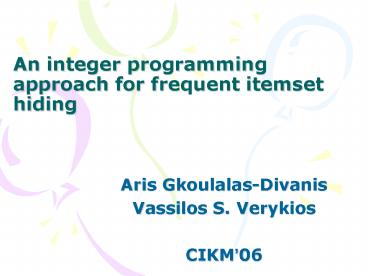An integer programming approach for frequent itemset hiding - PowerPoint PPT Presentation
1 / 28
Title:
An integer programming approach for frequent itemset hiding
Description:
An integer programming approach for frequent itemset hiding Aris Gkoulalas-Divanis Vassilos S. Verykios CIKM 06 – PowerPoint PPT presentation
Number of Views:98
Avg rating:3.0/5.0
Title: An integer programming approach for frequent itemset hiding
1
An integer programming approach for frequent
itemset hiding
- Aris Gkoulalas-Divanis
- Vassilos S. Verykios
- CIKM06
2
outline
- Introduction
- Basic definitions
- Methodology
- Experimental results
- Conclusions
3
introduction
- It based on the notion of distance between
original database and the sanitized database - goal minimized the distance based on the integer
programming while hiding the sensitive itemsets
and minimally affecting non-sensitive itemsets
4
Basic definitions
- the support count of itemsets in bitmap
representation
a b c
1 0 1
1 1 1
Maximizing the number of 1 left in D
non-sensitive itemsets should satisfy this rule
in D
sensitive itemsets should satisfy this rule in D
5
(cont.)
- Solving this problem is NP-hard ,there are 2m-1
inequalities (mtransactions lists)
6
(cont.)
- SIe,ae,bc (sensitive itemsets)
- Se,bc (minimal sensitive itemsets)
- SSe,ae,bc,ce,abc, set of all sensitive
itemsets and their supersets - Ideal case FF-SS ,santized database D to
contain all the frequent itemsets of D expect
from the sensitive ones
7
(cont.)
- Negative border
- Positive border
8
Border revision
null
A
B
C
D
BC
AD
AC
AB
BD
CD
ABC
BCD
ACD
ABD
ABCD
9
Problem size minimization
- Cthe total set of affected itemsets
- Lc the set of solutions of the corresponding
inequalities - remove the inequality of C2
without affecting the global solution of the
system then C2 covers C1
10
(cont.)
- Corollary any itemset belonging in the positive
border of F-SS covers all its subsets - gtB(F) cover all itemset of F
- B-(F) cover all itemsets of
- Ideal solution Lc
11
(cont.)
12
example
- FA,B,C,D,AB,AC,AD,CD,ACD
- SIAB,SAB
- FA,B,C,D,AC,AD,CD,ACD
- B(F)B,ACD
Bfrequent
ACDfrequent
ABinfrequent
13
Constraint satisfaction problem
- A solution of a CSP is a complete assignment of
values to the variables that satisfies all the
constraints - In CSP we usually wish to maximize or minimize an
objective function subject to a number of
constraints - To solve this problem we use binary integer
programming (BIP) that transform the CSP to an
optimization problem
14
Binary integer problem
15
Experimental results
- 10,000 transactions,10items,msup0.1
16
conclusions
- Defined a new metric to quantify the distance of
the initial database D and its sanitized version
D - It has benefit of being exact when ideal solution
can be identified
17
Exact knowledge hiding through database extension
- Aris Gkoulalas-Divanis
- Vassilos S. Verykios
- TKDE08
18
introduction
- The goal of the hiding algorithm is to create a
minimal extension DX to the original database DO
D
19
(cont.)
- Se,ae,bc
20
methodology
- PD NDo QDx
- ex e4,ae3,bc4
21
(cont.)
- The distance between Do and D is measured based
on the extension Dx
(minimize)
22
(cont.)
- Optimal solution set c
- Se,ae,bc mfreq0.3 Q4
- Ce,f,bc,bd,ab,acd
23
Safety margin
- The lower bound of Q under certain circumstances
be insufficient to allow for the identification
of an exact solution - Safety margin(SM) Expand the size of Q of Dx, it
can be predefined or be computed dynamically - Exsabc
- only 1 transaction is insufficient to
- provide an exact solution
24
(cont.)
- Null transaction
- (i) an unnecessarily large safety
- margin
- Should be removed from Dx
- (ii) a large value of Q essential for
- proper hiding
- Need to be validated ,since Q denotes the
- lower bound in the number of
transactions to - ensure proper hiding
25
(cont.)
- To ensure minimum size of Dx, the hiding
algorithm keeps only k null transactions - Qinvnull transaction
- VQSM-Qinv
- Ex sabc ,Q1 ,SM3
- Kmax(1-3,0)1
Null transaction
26
Experimental results
27
(cont.)
28
conclusions
- Use a minimal extension to the original database
- It has benefit of being exact when ideal solution
can be identified































